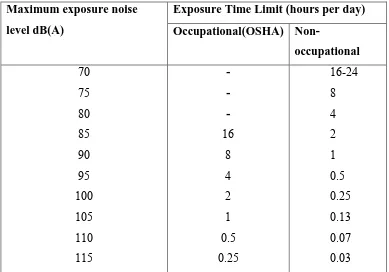SUPERVISOR DECLARATION
“I hereby declare that I have read this thesis and in my opinion this report is sufficient in terms of scope and quality for the award of the degree of
Bachelor of Mechanical Engineering (Structure & Materials)”
i
DESIGN OF A NOISE ENCLOSURE FOR PORTABLE GENERATOR
MOHD FAIZ BIN MOHD MOKHTAR
This report is submitted as partial fulfillment of requirement for the award Bachelor of Mechanical Engineering (Structure & Materials)
Fakulti Kejuruteraan Mekanikal Universiti Teknikal Malaysia Melaka
ii
DECLARATION
“I hereby declare that the work in this report is my own except for summaries and quotations which have been duly acknowledged.”
Signature:
Author :
iii
iv
ACKNOWLEDGEMENT
First and foremost, thank Allah the Almighty for blessing me to complete my Final Year Project 1 Report. I would like to take this opportunity to record my utmost and sincere gratitude to my supervisor, Dr. Azma Putra Without him, I can never start work on my project and report and to proceed until this point of development. He has shown me knowledge, important advice, guidance and inspiration throughout the project time period. I also would like to thank my examiner, Pn. Siti Norbaya for his commitment and kindness throughout the project time period.
v
vi
ABSTRACT
vii
ABSTRAK
x
xi
LIST OF TABLES
NO TITLE PAGE
1.1 Guideline for Occupational and Non-occupational
Noise Exposure Time Limit 4
2.1 A-Weighting for 1/3 Octave Frequency 13
2.2 Sources, Sound Power and Sound Power Level 18
3.1 International Standard (ISO 3746) specification
for determining the sound power levels
of machine and equipment 25
3.2 The coordinates of microphones position in terms
of distance from centre of hemisphere along three
mutually perpendicular axes (x, y, z) 26
3.3 The material and thickness 28
3.4 Apparatus used for the experiment 30
4.1 Values of Wtotaland LWfor incident energy
and transmitted energy for aluminium 43
4.2 Values of Wtotal and LW for incident energy and
transmitted energy for steel 44
4.3 Comparison between aluminium and steel 44
4.4 Values of Wtotaland LWfor transmitted energy
xii
LIST OF FIGURES
NO TITLE PAGE
1.1 Environmental Noise Effect Schemas 3
1.2 Typical sound level in sound pressure level (decibels)
and PSI 6
1.3 Portable Generators 6
2.1 International standards A-, B-, C- and D-weighting
curves for sound level meter 12
2.2 A-Weighting Frequencies 12
2.3 Measuring Sound Power Level according to
ISO 3745 in the anechoic room 20
2.4 Sound Transmission Loss of Partition 21
2.5 Comparison of theory and measurement for
homogeneous and isotropic materials 23
3.1 The microphones array on the hemisphere 26
3.2 Equipment diagram for the experiment 29
3.3 Holes at the roof of the enclosure 32
3.4 Air intake holes 32
3.5 Flexible exhaust pipe 33
4.1 Graph of sound power level versus frequency
of four measurement points at radius 1 m 35
4.2 Graph of Transmission Loss versus Frequency of
xiii
4.3 Graph of Transmission Loss versus Frequency for
Steel for different thickness 37
4.4 Graph of surface sound power level versus frequency 38
4.5 Graph of incident sound power level (LWi)
versus Frequency 39
4.6 Comparison between calculated incident sound power
level with calculated transmitted sound power level
versus frequency for aluminium 41
4.7 Comparison between calculated incident sound
power level with calculated transmitted sound
power level versus frequency for steel 42
4.8 Graph of sound power level versus frequency of four
measurement points at radius 1 m 45
4.9 Graph of surface sound power level versus frequency 46
4.10 Graph of transmitted sound power level (LWtmea)
versus Frequency 47
4.11 The comparison of calculated incident sound power
level with measurement transmitted sound power level
versus frequency 48
4.12 The comparison of calculated incident sound power
level with calculated transmitted sound power level and also with measured transmitted sound power
xiv
r Radial distance between receivers to the source
f Frequency (Hz)
W The 0 dB reference level
xv pA
L The A-weighted surface sound pressure level in decibels
pAi
L The A-weighted sound pressure level at the ith measurement
position
N The total number of the measurement position
WA
L Sound pressure level of the source
K The environmental correction to account for the influence of
reflected sound
Wtc
L Calculated transmitted sound power level
Wi
L Incident sound power level
total
W Total of sound power level
Wtmea
1
CHAPTER I
INTRODUCTION
1.1 BACKGROUND
1.1.1 Environmental Noise
Noise means any unwanted sound that we are exposed everyday without any
consideration. Noise defined as a sound or sounds at such amplitude as to cause
annoyance or to interfere with communication and it was mentioned that noise was psychological and subjective feeling. It can be block, change or interfere with the meaning of a message in human, animal and electronic communication. Noise can cause a physical problem such as permanent hearing loss and also the psychological problem, like stress.
2
Most people are affected by noise exposure more than any other environmental stimulus. The most widespread problem created by noise is nuisance. Noise has been known as stressor which can cause a several serious health effect. Environmental noise affects us in the following areas:
a) Hearing Loss
The most notable effect of environmental noise is hearing loss. It affected if the noise is loud enough and the exposure long enough. Noise induced hearing loss is usually gradual and painless, but unfortunately, hearing loss is a permanent effect. Once destroyed, the hearing nerve and it sensory nerve cell do not regenerate.
b) Cardiovascular Effect
Exposure to environmental noise during sleep bring to a number of physiological effect such as increased of blood pressure, increased heart rate and an increase in body movements. Environmental noise probably affects the cardiovascular system through the stimulation of hormones in our body such as cortisol, noradrenaline and also adrenaline.
c) Annoyance and Quality of Life
Environmental noise is a subjective experience and feelings of annoyance are profoundly affected by personal attitudes and also belief. It is because environmental noise is commonly perceived to be an avoidable form of harm and an intrusion into personal privacy that creates such unhappiness. Road traffic is the main effect that causes environmental noise. The noise from the transport is associated with productivity losses by an inability to concentrate at work and tiredness caused by disturbed sleep.
d) Sleep Disturbance
3
Figure 1.1: Environmental Noise Effect Schemas
1.1.2 Noise Standard
According to the Occupational Safety and Healthy Administration OSHA, exposure to high level of noise for long durations may lead to hearing loss, create physical and psychological stress, reduce productivity, interfere with communication and contribute to accidents and injuries by making it difficult to hear warning signals. The maximum permissible occupational noise exposure limit in the range of 90-85 dB(A) Leq for 8 hour per day (40 hour per week) have been recommended by the International Standards Organization (ISO).
4
exceed 85 dB(A). For non-occupational areas, the maximum level for a duration of 16 to 24 hours is 70 dB(A). Figure 1.2 illustrates typical sound levels for several conditions.
Table 1.1:Guideline for Occupational and Non-occupational Noise Exposure Time Limit
Maximum exposure noise level dB(A)
Exposure Time Limit (hours per day) Occupational(OSHA)
Non-ECMA Standard specifies procedures for measuring and reporting the noise emission of information technology and telecommunications equipment. This
Standard is considered part of a noise test code for this type of equipment, and is
based on basic noise emission standards ISO 3741:1999 , ISO 3744:1994 , ISO
3745:2003 and ISO 11201:1995 . The basic emission quantity is the A-weighted sound power level which may be used for comparing equipment of the same type but from different manufacturers, or for comparing different equipment.
5
measurements in a reverberation room; the other two (ISO 3744 and ISO 3745) specify measurements in an essentially free field over a reflecting plane. Any one of these three basic noise emission standards may be selected and shall then be used exclusively according to this Standard when determining sound power levels of a machine.
The A-weighted sound power level is supplemented by the A-weighted emission sound pressure level measured at the operator position(s) or the bystander positions, based on the basic noise emission standard ISO 11201. This sound pressure level is not a worker's emissions rating level, but it may assist in identifying any potential problems that could cause annoyance, activity interference, or hearing damage to operators and bystanders.
The ECMA Standard is suitable for type tests and provides methods for manufacturers and testing laboratories to obtain comparable results. The methods specified in ECMA Standard allow the determination of noise emission levels for a unit tested individually.
The procedures may be applied to equipment which emits broad-band noise, narrow-band noise and noise which contains discrete-frequency components, or impulsive noise.
6
Figure 1.2:Typical sound level in sound pressure level (decibels) and PSi
1.1.3 Environmental Noise From Portable Generator
Portable generators are used very commonly in construction, shops, offices and homes today in order to supply and maintain power during power shutdowns or in an emergency power outage. The generator needed to be both mobile and quiet since it would often be used near commercial or residential areas. These generators emitted very high levels of noise, in addition to noxious air emissions. The noise may be generated by aerodynamic effects or due to forces that result from combustion process or may result from mechanical excitation by rotating or reciprocating engine components.
7
1.2 PROBLEM STATEMENT
A portable generator is a one of sources that affect the environmental noise. Although the noise level might not harm the human hearing, the noise emit by a portable generator cause disturbance to the environmental. Moreover, in practice, most people do not cover the portable generator to reduce its noise emission.
1.3 OBJECTIVES OF THE PROJECT The objectives of this project are:
a) To measure the sound power level that emitted from a portable electric
generator.
b) To design and manufacture a simple enclosure for reducing
8
1.4 METHODOLOGY
This project begins with a literature review, particularly related to theory of the sound transmission loss and also the theory of sound power level measurement. Literature review consists of studying the previous research established journal, articles, academic book and other related references to obtain the theory.
After obtaining all the theory related, the next step is to measure the sound power level that emit by the portable generator. The measurement of the sound power level will conduct outdoor which is with minimum background noise and reflecting surface. The sound power level that emit by portable generator will be measure by using acoustic microphones.
Once the sound power level is obtained, this becomes ‘an input’ to design an enclosure to meet the target of noise reduction. Theoretical formula will be used to calculate the dimensions and type of material for the enclosure. This involved the sound and structural vibration analysis. The nest step, the measurement of the sound power level from the portable generator with the noise enclosure which has been designed will be conducted. The result will be compared with the acceptable noise standard.

